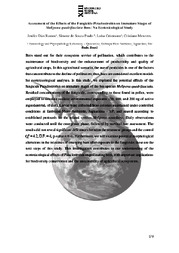Assessment of the effects of the fungicide piraclostrobin on immature stages of Melipona quadrifasciata bees: an ecotoxicological study.
Assessment of the effects of the fungicide piraclostrobin on immature stages of Melipona quadrifasciata bees: an ecotoxicological study.
Autoria: RAMOS, J. D.; PRADO, S. de S.; CRISTMANN, L.; MENEZES, C.
Resumo: Bees stand out for their ecosystem service of pollination, which contributes to the maintenance of biodiversity and the enhancement of productivity and quality of agricultural crops. In this agricultural scenario, the use of pesticides is one of the factors that can contribute to the decline of pollinators; thus, bees are considered excellent models for ecotoxicological analyses. In this study, we explored the potential effects of the fungicide Piraclostrobin on immature stages of the bee species Melipona quadrifasciata. Residual concentrations of the fungicide, corresponding to those found in pollen, were employed to simulate realistic environmental exposures (50, 100, and 200 ng of active ingredient/mL of diet). Larvae were collected from colonies maintained under controlled conditions at Embrapa Meio Ambiente, Jaguariúna - SP, and reared according to established protocols for the related species Melipona scutellaris. Daily observations were conducted until the emergence phase, followed by survival rate assessment. The results did not reveal significant differences between the treatment groups and the control (?² = 4.2, D.F. = 4, p-value = 0.4). Furthermore, we will examine potential morphological alterations in the intestines of emerging bees after exposure to the fungicide; these are the next steps of this study. This investigation contributes to our understanding of the ecotoxicological effects of Piraclostrobin on pollinating bees, with important implications for biodiversity conservation and the sustainability of agricultural ecosystems.
Ano de publicação: 2024
Tipo de publicação: Resumo em anais e proceedings
Unidade: Embrapa Meio Ambiente
Palavras-chave: Fungicides, Melipona quadrifasciata
Observações
1 - Por padrão são exibidas publicações dos últimos 20 anos. Para encontrar publicações mais antigas, configure o filtro ano de publicação, colocando o ano a partir do qual você deseja encontrar publicações. O filtro está na coluna da esquerda na busca acima.
2 - Para ler algumas publicações da Embrapa (apenas as que estão em formato ePub), é necessário ter, no celular ou computador, um desses softwares gratuitos. Sistemas Android: Google Play Livros; IOS: iBooks; Windows e Linux: software Calibre.
Acesse outras publicações
Acesse a Base de Dados da Pesquisa Agropecuária (BDPA) para consultar o acervo completo das bibliotecas da Embrapa.

